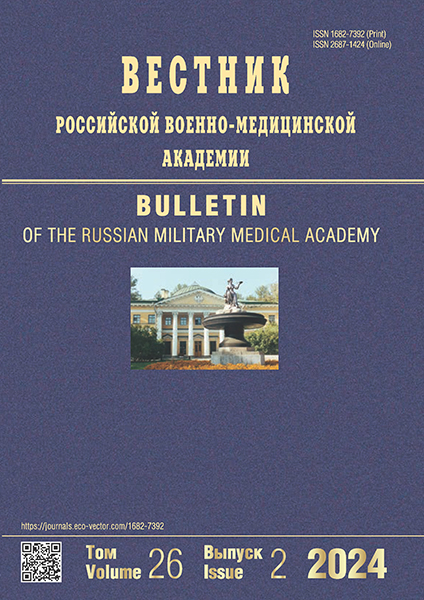Prevalence of gastritis and gastric and duodenal ulcers in Russian Guard servicemen
- 作者: Ushaeva L.A.1,2, Zavyalov D.V.2, Shubin L.B.2
-
隶属关系:
- 2nd Military Clinical Hospital of Rosgvardiya
- Yaroslavl State Medical University
- 期: 卷 26, 编号 2 (2024)
- 页面: 259-266
- 栏目: Original Study Article
- ##submission.dateSubmitted##: 26.12.2023
- ##submission.dateAccepted##: 09.04.2024
- ##submission.datePublished##: 03.06.2024
- URL: https://journals.eco-vector.com/1682-7392/article/view/625308
- DOI: https://doi.org/10.17816/brmma625308
- ID: 625308
如何引用文章
详细
Based on the annual statistical reports for 2018–2023 and the cumulative median prevalence of various studies in 2009–2020 in Russia, the prevalence of peptic ulcer with uncomplicated and complicated course and various forms of gastritis in servicemen of the Regardie of the North Caucasian District was estimated, and the current trends are explained. The incidence of peptic ulcer with uncomplicated and complicated course and various forms of gastritis among the servicemen of the Regardie of the North Caucasian District for the specified period ranged from 11.521% to 16.351% (confidence interval: 10.515–12.588 and 15.233–17.517, respectively) and from 27.212% to 51.889% (confidence interval: 25.791–28.669 and 50.316–53.460, respectively). Random effects analysis has demonstrated different true effect sizes relative to the overall average. The revealed statistical patterns are only the first stage in an ongoing study on the prevalence of upper gastrointestinal diseases among the servicemen of the Regardie of the North Caucasian District. In general, the prevalence of peptic ulcer disease, including with a complicated course, and various forms of gastritis among military personnel was 13.270% and 37.679%, respectively (confidence interval: 10.617–16.170 and 24.292–52.102, respectively), showing an upward trend. The expected prevalence of peptic ulcer and gastritis in 2023 was 16,351 and 51,889%, respectively, which is not accidental and depends on the impact of specific risk factors. The identification of risk factors enables the development of measures to prevent delayed complications of the pathology under study and improvement of health in servicemen of the Regardie of the North Caucasian District. Thus, the study of the health status of the general population and military personnel, in particular, and the effect of various environmental factors determines their social significance both in military medicine and the structure of the healthcare system.
全文:
作者简介
Lyudmila Ushaeva
2nd Military Clinical Hospital of Rosgvardiya; Yaroslavl State Medical University
编辑信件的主要联系方式.
Email: analitika2301@mail.ru
ORCID iD: 0009-0007-6037-8960
SPIN 代码: 7169-8706
MD, Cand. Sci. (Med.)
俄罗斯联邦, Pyatigorsk; YaroslavlDmitry Zavyalov
Yaroslavl State Medical University
Email: zavialoff@mail.ru
ORCID iD: 0000-0002-9173-6878
SPIN 代码: 8048-7985
MD, Dr. Sci. (Med.), associate professor
俄罗斯联邦, YaroslavlLeonid Shubin
Yaroslavl State Medical University
Email: LBSH@yandex.ru
ORCID iD: 0000-0003-4562-7731
SPIN 代码: 8021-7289
MD, Cand. Sci. (Med.), associate professor
俄罗斯联邦, Yaroslavl参考
- Ivashkin VT, Maev IV, Tsarkov PV, et al. Diagnosis and treatment of peptic ulcer disease in adults (Clinical recommendations of the Russian gastroenterological association, the Russian society of colorectal surgeons and the Russian endoscopic society). J Gastroenterol Hepatol. 2020;30(1):49–70. (In Russ.) EDN: IMFOZP doi: 10.22416/1382-4376-2020-30-1-49-70
- Roberts-Thomson IC. Rise and fall of peptic ulceration: A disease of civilization? J Gastroenterol Hepatol. 2018;33(7):1321–1326. doi: 10.1111/jgh.14090
- Wang FW, Tu MS, Mar GY, et al. Prevalence and risk factors of asymptomatic peptic ulcer disease in Taiwa. World J Gastroenterol. 2011;17(9):1199–1203. doi: 10.3748/wjg.v17.i9.1199
- Sung JJ, Kuipers EJ, El-Serag HB. Systematic review: the global incidence and prevalence of peptic ulcer disease. Aliment Pharmacol Ther. 2009;29(9):938–946. doi: 10.1111/j.1365-2036.2009.03960.x
- Zhebrun AB., Alexandrova VA., Goncharova LB., et al. Diagnosis and treatment of diseases of the gastrointestinal tract associated with Helicobacter pylori infection. Saint Petersburg: SPbMAPO; 2002. 32 р. (In Russ.)
- Sirotko ML, Aleshchenko SF, Sushkova TN, et al. The relevance and efficiency of early detection of digestive diseases during screening of the adult population of Russia. Profilakticheskaya medicine. 2017;20(3):22. (In Russ.) doi: 10.17116/profmed201720322-27
- Denisova TP, Shuldyakov VA, Tyultyaeva LA, et al. Monitoring of the prevalence of diseases of internal organs by the example of digestive system pathology. Saratov Journal of Medical Science. 2011;7(44):772–776. EDN: OWRAXX
- Shuldyakov VA, Tyultyaeva LA, Denisova TP, et al. Population aspects of the formation of gastroenterological pathology in people of different ages. Saratov Journal of Medical Science. 2011;7(4): 783–786. (In Russ.) EDN: OWRAZB
- Litovsky IA., Gordienko AV. Gastroduodenal ulcers and chronic gastritis (gastroduodenitis). Debatable issues of pathogenesis, diagnosis, treatment. Saint Petersburg: SpetsLit; 2017. 302 р. (In Russ.) EDN: VMARSG
- Tyultyaeva LA. Clinical and epidemiological parameters of the course of diseases of the digestive system in conditions of social stress and ways to improve gastroenterological care for the population [dissertation abstract]. Samara; 2009. 37 р. (In Russ.)
- Trush OV. The quality of medical care for patients with chronic gastroduodenitis and peptic ulcer disease [dissertation abstract]. Saint Petersburg; 2007. 24 р. (In Russ.)
- Zakharova OV. Scientific substantiation of improving the organization of gastroenterological aid to the adult population in the conditions of megacity (on the example of Nizhny Novgorod) [dissertation abstract]. Ryazan; 2011. 26 р. (In Russ.)
- Deinega VI, Fadeev AV, Kruchinina NE, et al. Comparative characteristics of some factors of the pathogenesis of chronic gastroduodenal pathology in military personnel of various professional groups. Military-Medical Journal. 2006;327(4):29–96. EDN: HTOMCF
- Bykov AL. Military field therapy: national manual / Bykova IYu, Rakova AL, Sosyukina AE, editors. Moscow: GEOTAR-Media; 2007. 416 p. (In Russ.)
- Epidemiological dictionary for international. epidemiological association / Lasta JM, editor. Moscow: Globus; 2009. 316 p. (In Russ.)
- Higgins JPT, Green S. Cochrane handbook for systematic reviews of interventions. Version 5.1.0. [updated March 2011]. The cochrane collaboration. UK: London; 2011. 674 р.
- Grigoriev SG, Evdokimov VI, Sivashchenko PP. Medical and statistical indicators of the state of health of servicemen of the Armed Forces of the Russian Federation (2003–2016). Saint Petersburg: Polytechnic-servis; 2017. 119 р. (In Russ.)
补充文件








